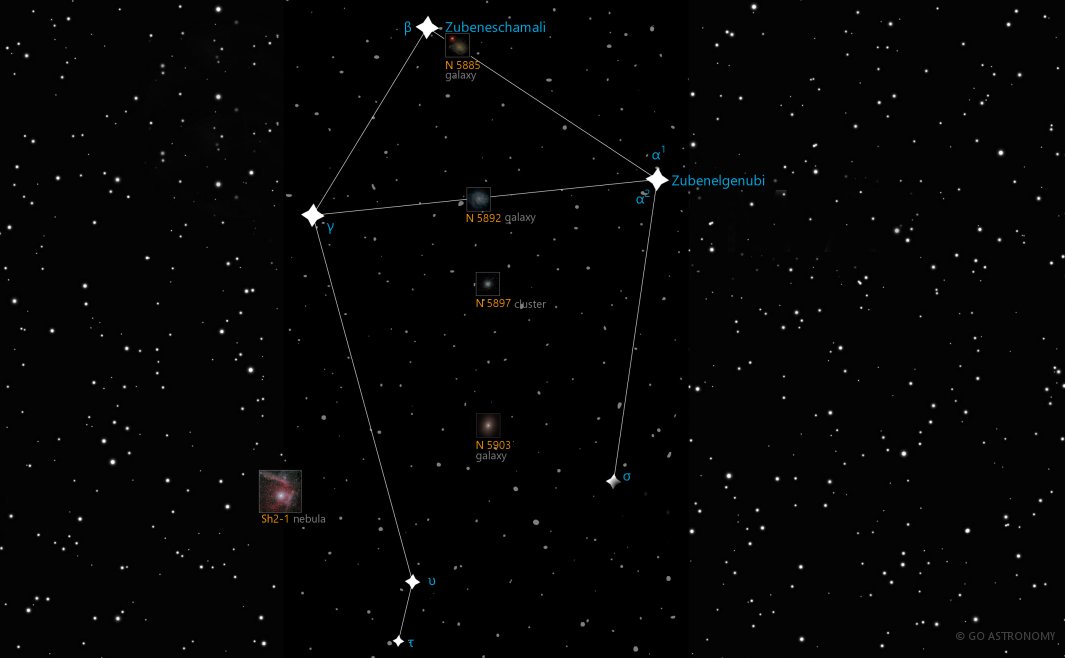Libra, the Balance (Lib)
(LIB-bru)
The Southern constellation of Libra, the Balance, is best viewed in Summer during the month of June.
Libra is the 29th largest constellation. It's brightest star is Zubeneschamali at magnitude 2.61. The boundary of the Libra constellation contains 8 stars that host known exoplanets.
- Pronunciation:
- LIB-bru
- Meaning:
- Balance
- Genitive:
- Librae
- Abbreviation:
- Lib
- Constellation Family:
- Zodiacal
- Hemisphere:
- Southern
- Quadrant:
- SQ3
- Visibility:
- 65° N - 90° S
- Best viewing month*:
- June
- Area:
- 538 sq. degrees
- Size:
- 29th largest
- Right Ascension (avg):
- 15h 11m
- Declination (avg):
- -16°
- Brightest star:
- Zubeneschamali (2.61)
- Stars with planets:
- 8
- Messier objects:
- |
- Caldwell objects:
- |
Brightest Stars in Libra
The 10 brightest stars in the constellation Libra by magnitude.
- Star
- Magnitude
- Spectral class
- Beta Librae (β Lib)
- 2.61
- B8V
- Alpha Librae (α2 Lib)
- 2.75
- A3IV
- Sigma Librae (σ Lib)
- 3.25
- M3/M4III
- Upsilon Librae (υ Lib)
- 3.6
- K3III
- Tau Librae (τ Lib)
- 3.66
- B2.5V
- Gamma Librae (γ Lib)
- 3.91
- K0III
- Theta Librae (θ Lib)
- 4.13
- K0III
- 16 Librae (16 Lib)
- 4.47
- F0V
- Iota Librae (ι1 Lib)
- 4.54
- Asp
- 37 Librae (37 Lib)
- 4.61
- K1IV
Double Stars in Libra
These are the brightest and easiest-to-find double, triple, and quadruple star systems in the constellation Libra. Also see all star clusters.
- Star system
- Magnitudes
- Type
- Alpha Librae
- 2.7, 5.2
- double
Star Clusters in Libra
The most notable and easy-to-find star clusters in the constellation Libra . Also see all star clusters.
Galaxies in Libra
The most notable galaxies in the constellation Libra. Also see all galaxies.
The Scales Constellation
Libra, the Latin word for "scales," is a constellation nestled in the celestial sphere's southern region. Not only does it have a unique historical significance as an ancient symbol of justice, but it also hosts a number of interesting celestial objects that make it a compelling topic for astronomers.
Historical Overview
Libra is one of the twelve constellations of the zodiac, recognized by many ancient civilizations, including the Babylonians, Greeks, and Romans. For the Greeks and Romans, Libra was not a separate entity, but was considered to be part of Scorpius, representing the claws of the scorpion. However, the Romans, influenced by the Egyptians, later saw the constellation as the Scales of Justice held by the goddess Astraea, represented by the neighboring constellation Virgo.
Location and Main Features
Located in the third quadrant of the southern hemisphere (SQ3), Libra is visible between latitudes +65? and -90?. It is bordered by Serpens Caput, Virgo, Hydra, Centaurus, Lupus, Scorpius, and Ophiuchus. With an area of 538 square degrees, Libra ranks 29th in size among the 88 recognized constellations.
Major Stars
Libra features several significant stars. Its brightest star, Beta Librae, also known as Zubeneschamali, is a blue dwarf approximately 185 light-years from Earth and shines at a magnitude of 2.6. Its name is derived from the Arabic for "The Northern Claw," harkening back to when Libra was part of Scorpius.
Alpha Librae, or Zubenelgenubi, meaning "The Southern Claw," is a binary star system consisting of an A3 primary star and an F4 secondary star. It's located about 77 light-years away. Gamma Librae, or Zubenelakrab, is an orange giant star approximately 152 light-years away and has a magnitude of 3.91.
Deep Sky Objects
Libra is also home to several interesting deep-sky objects. For instance, the constellation contains the star systems Gliese 581 and Gliese 570. Gliese 581, a red dwarf about 20 light-years away, is known for its system of exoplanets, including one in the star?s habitable zone where conditions could be right for life.
The constellation also hosts a few galaxies, such as NGC 5890, an elliptical galaxy with a magnitude of 12.7, and NGC 5885, a spiral galaxy with a magnitude of 12.1.
Observation
For observers in the northern hemisphere, Libra is best viewed during the summer months. Because of its position in the zodiac, the constellation can be easily located by tracking the path of the sun across the sky. To the unaided eye, the constellation's stars appear faint but can be seen more clearly with binoculars or a telescope, which are necessary for viewing its deep-sky objects.
Libra in Modern Astronomy
Today, Libra continues to be a topic of interest for both professional and amateur astronomers. Its stars serve as markers for tracking the motion of the planets and the sun. Additionally, its exoplanet-hosting stars, such as Gliese 581, have caught the interest of scientists searching for life beyond our own solar system.
* Constellation shown for northen hemisphere skies. For the southern hemisphere, constellations appear rotated 180 degrees (upside-down and left-right reversed) from what is shown. Remember that seasons are reversed too - summer in northern latitudes is winter in southern latitudes.
** Circumpolar constellations are visible year-round in the hemisphere listed (and not at all in the opposite hemisphere).





